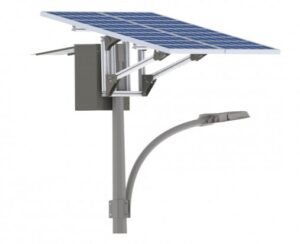Table of Contents
As cities grow and sustainability becomes more of a priority, the demand for energy-efficient and environmentally friendly solutions has increased. One such solution is the solar panel street light, which combines renewable energy and advanced technology to provide reliable lighting for streets and public spaces. In this article, we explore the key features and benefits of solar panel street lights, highlighting their eco-friendly nature, energy efficiency, and cost-effectiveness.
The Role of Solar Panel Street Lights in Sustainable Urban Development
Solar panel street lights are designed to harness the power of the sun to illuminate streets, pathways, and public areas without relying on traditional grid electricity. By using solar panels to capture solar energy during the day, these lights store the energy in batteries and use it to power the light at night. This innovative design makes solar panel street lights an ideal solution for outdoor lighting, especially in areas that may lack access to the main power grid.

Key Features of Solar Panel Street Lights
One of the standout features of solar panel street lights is their ability to operate independently of the electrical grid. This makes them a perfect choice for remote locations where extending power lines can be costly or impractical. Additionally, solar panel street lights are equipped with high-quality LED lights that offer bright illumination with minimal energy consumption.
Another advantage is the minimal maintenance required. These lights are designed to be durable and weather-resistant, capable of withstanding various environmental conditions. With a lifespan that typically exceeds conventional street lights, solar panel street lights provide long-term value and reduce the need for frequent replacements.
Energy Efficiency and Environmental Impact
Solar panel street lights are highly energy-efficient, as they rely on clean, renewable solar energy rather than fossil fuels. This not only helps reduce carbon emissions but also lowers energy costs. Since they are powered by the sun, they operate without contributing to the depletion of natural resources. This eco-friendly solution is ideal for cities and municipalities aiming to meet sustainability goals while maintaining effective urban lighting.
Moreover, solar panel street lights contribute to the reduction of light pollution. Traditional street lights often emit excess light, disrupting the natural environment and ecosystems. In contrast, solar-powered street lights can be designed to focus light in specific areas, minimizing the impact on wildlife and the night sky.
Cost-Effectiveness and Long-Term Benefits
Although the initial cost of installing solar panel street lights can be higher than traditional street lighting systems, the long-term savings are substantial. Solar panel street lights do not require a continuous supply of electricity, which significantly reduces operational costs. Furthermore, the minimal maintenance and long lifespan of these lights contribute to further savings over time.
In addition, the installation of solar panel street lights eliminates the need for costly infrastructure such as power lines, making them an attractive option for both urban and rural areas. Over time, these savings can offset the initial investment and provide a high return on investment for municipalities and businesses.
Conclusion
Solar panel street lights represent a promising solution to the growing need for sustainable, energy-efficient, and cost-effective outdoor lighting. Their ability to harness solar energy, coupled with their minimal environmental impact, makes them a key player in the transition toward greener, more eco-conscious cities. As the technology continues to evolve, solar panel street lights will undoubtedly become a central part of urban development, providing reliable, eco-friendly lighting for communities worldwide.
0









